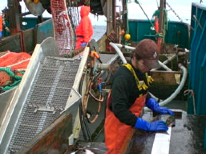| Principle 1: One size does not fit all. Catch Share programs need to be designed to fit the unique characteristics of the fishery to which the program will be applied. The wide variety of Catch Share programs in Alaska underscores this point.
Principle 2: Catch Share programs must be developed through an open and transparent process accessible to all of the various interests that might be affected by the program. The Regional Fishery Management Council process provides such transparency, and is the best place for such programs to be developed.
Principle 3: Any Catch Share program needs to take into account, and to the extent feasible, address in a fair and equitable manner the interests of the harvesters, processors, and communities directly involved in the fishery. Catch Share programs should consider mechanisms to provide access for entry-level fishermen or other entry level opportunities as may be appropriate for the specific fishery involved recognizing that such opportunities may not be appropriate in all instances. Clearly, each program will be unique and needs to tailor these considerations to meet the specific conditions of the fishery involved. In Alaska, each Catch Share program has specific provisions to address these considerations. Every Catch Share program in Alaska also includes entry level provisions of one form or another.
Principle 4: Catch Share programs should have clear conservation, economic, and social goals and objectives, and include mechanisms to review and adjust the program to improve performance as the program matures. Flexibility will be needed to address unforeseen consequences of initial design or changes in a fishery that may occur over time. However, Catch Share programs also need to provide long term stability to ensure stewardship. Care must be taken with regards to transferability of shares or rights, and measures avoided that might create incentives for participants to pursue short term gain over longer term investment in conservation and economic sustainability. |

Principle 5: Catch Share programs need to be managed on scientifically based annual catch limits, including mechanisms to control and reduce bycatch as well as specific measures to prevent overfishing. In Alaska, extensive management measures are in place to address overfishing, bycatch, habitat protection, and ensure risk averse management while maintaining economically robust fisheries. Catch Share programs are an important tool in the management process for augmenting these programs to meet conservation and management goals.
Principle 6: Catch Share programs should have robust monitoring programs including observers, electronic monitoring, Vessel Monitoring Systems, or other independently verifiable mechanisms to monitor target catch and bycatch.
For more information on Catch Shares and other sustainable fisheries projects, go to:
www.marineconservationalliance.org
|